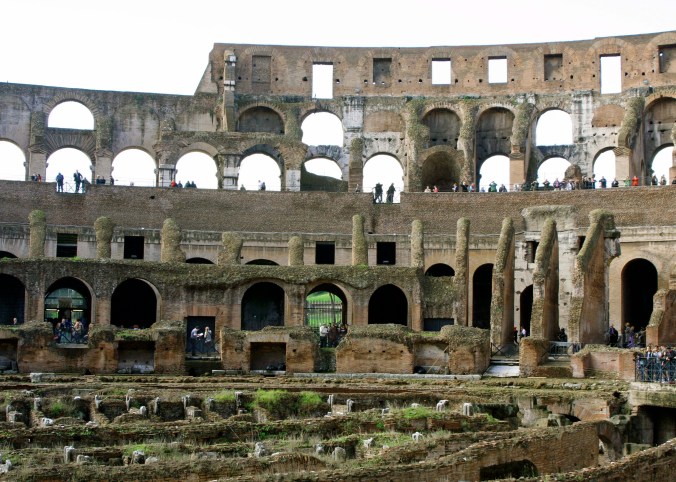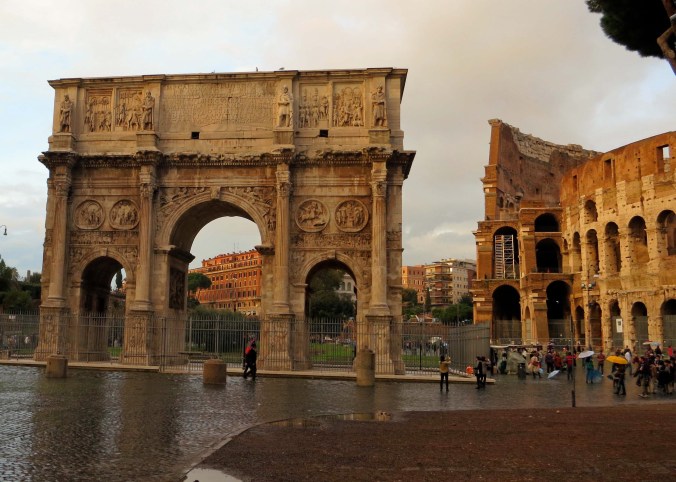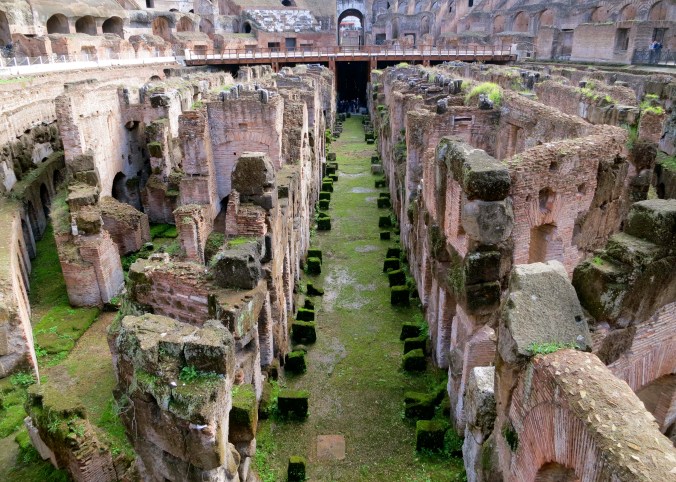This is the third in my series of introducing new followers to what they can expect to find on my blog. This series reflects a trip that Peggy and I took visiting a number of locations in the Mediterranean. Go here and scroll forward or backwards to discover more of the series: https://wandering-through-time-and-place.com/2013/05/01
I first viewed Rome’s grand memorial to gladiators in 1967. I was as impressed with the number of feral cats living in the ruins as I was with the structure. Massive renovations have taken place since then. Today’s Colosseum is crowded with tourists instead of cats. We joined the throngs.

This is the one cat I found in the Colosseum. I am sure it had aunts, uncles, cousins, parents, kids, etc. somewhere. But check out the stance… ears back, paw posed to strike. He was ready to take on a gladiator, or at least a camera toting tourist.
Originally the Colosseum was known as the Flavian Amphitheater, after the family of emperors who built it. Nero, who had a bad case of self-adulation, built a huge statue of himself nearby. It was known as the Colossus. At some point, the name was applied to the Colosseum. A later emperor, by the way, removed the head from Nero’s statue and affixed his own stone likeness on top. Why pay for a whole statue? It became the custom with each succeeding emperor. So much for everlasting fame…
When completed in 80 AD, the Colosseum could seat 50,000 screaming people. Some 2000 gladiators killed each other and 9000 animals over the 100 day inauguration.
While their taste in entertainment might be questionable, the Romans’ engineering abilities were superb. The Colosseum is high testament to this. Modern stadiums are still built on a similar model, designed to move large numbers of people in and out quickly. I was amused to learn that the Romans called the entrance/exit passages vomitoria– hence our word, vomit.
Spectators were issued tickets on pottery shards that listed their entrance gate, section, row and seat numbers. The higher your rank, the better your seat. The top rows were saved for slaves, foreigners and women. Some people, such as actors and gravediggers, weren’t allowed in the Colosseum at all. Now we elect actors as presidents and governors. Gravediggers are still gravediggers.

The early Roman crowds have arrived for their day of entertainment at the Colosseum in this illustration of the upper tier. Cooking, eating, drinking, fighting and betting were all part of a typical day. As was carving graffiti on the benches. (Illustration from Colosseum exhibit)
The top could be covered for bad weather by a large canvas awning that was put up and taken down by sailors from Rome’s navy. The true gem of engineering was the floor, however, which covered a network of tunnels and cages where wild animals and props were stored. Eighty different elevators operated by pulleys served to bring scenery and wild animals to the surface. You might be in the middle of an African jungle for one scene and a Greek city the next.

This illustration from the Colosseum shows a cutaway of the floor with its elevators, wild animals and gladiators. (Illustration from Colosseum exhibit)

Here’s what the Colosseum would have looked like with its awning. (Illustration from Colosseum exhibit)
And you never knew when or where the next wild animal might pop up, which could be bad news for gladiators. Cats at the Colosseum then meant lions and tigers with long claws and sharp teeth, oh my. There were also elephants, rhinos, hippos, crocodiles and even giraffes–although I can’t imagine why or how you would fight a giraffe. I once chased a herd across the Serengeti Plains in a Volkswagen beetle, however.
Gladiators came from the ranks of slaves, poor people, and criminals. (Contrary to legend, there were very few Christians.) The most successful earned fame, fortune and freedom. Rick Steves, in his book on Mediterranean Ports, reports they even gave endorsements. I can see it in neon lights, “Barbarian Bob eats at Papa’s Pizzeria.”

This photo, taken from the opposite end of the Colosseum provides a perspective on what the floor might have looked like. Only about a third of the original Colosseum remains. While earthquakes have done their share of damage, much more was done by Romans taking building blocks and iron supports for use in other construction throughout Rome.

We started our tour on the upper level of the Colosseum. In addition to providing views into the arena, the walkway provided views of the surrounding city and Rome’s ancient Forum. (Photo by Peggy Mekemson)

Peggy took this photo from the lower level looking up at the upper level. Special tours also take visitors to the lower, basement level. (photo by Peggy Mekemson)

Roman emperors loved their triumphal arches even more than they loved statues. It provided a very public opportunity to show how great they were. The Arch of Constantine is located right next to the Colosseum.





An engineering MARVEL, most absolutely…. But such a sad place in the history books.
Interestingly, FeyGirl, I read that the Colosseum has become a symbol in the fight against capital punishment. When a person’s death sentence is commuted, the night lights on the Colosseum are gold instead of white.
WOW… That’s fascinating. I had no idea!!!
Seeing the Colosseum at night is a “must see.” It was quite magical and my imagination went wild!
Considering your imagination isn’t that tame to start with, that’s pretty wild… (grin)
Beautiful piece of architecture.. once more, I am amazed at this amazing piece of history..great pictures!!
Thanks Lynne. 🙂
I think it was interesting that there were 80 elevators that could bring animals up in lots of different places and i thought it was interesting that there were so many feral cats in the Colosseum.BRICE CART
The elevators would be down right spooky if your life depended on where the next animal might appear! As for the cats, they are common at ruins throughout the Mediterranean. Thanks for your comments Brice.
Curt
Unbelievable photos C & P, and great anecdotes. Thanks for sharing. And thanks for the compliment. I am, truth be told, a terrible horse woman. Just a wannabe. But! Max wants one of those hats. 😀
Max could be the best dressed horse in Ohio. Other horses would kill to have his ears. (grin)
Hi,
Where did you get the photos from the Colosseum Exhibit? Did you take them yourself? Thank you
Hi Thomas… My wife Peggy and I took all of the photos. Inside we took a few photos of exhibits that illustrated various aspects of the building. –Curt
I had absolutely no idea the Coliseum housed wild animals in that magnitude. While a movie is but a movie (imagination), “Gladiator” depicted a scene where a lion came onto the field.
An you used the term “inauguration”… leading up to…what? Regardless, 2,000 gladiators perished each “season”? I read somewhere recently they also uncovered remains from female gladiators.
Peggy’s photos are wonderful as always…
Another post to show my boy. And he knows all about the ferals – from the neighborhood – as well as a lot about the gladiators from his study of Ancient Rome. Beautiful shots he will love. SO interesting! All the best in the coming year, my friend.
The Colosseum is spectacular, and more so in person than in photos. Thanks. And a very Happy New Year to you as well.
You guys did great with this post. My son and I enjoyed it and learned a lot. Giraffes. HUH. (Weird). You and Peggy make a mean team. Thanks for bringing history alive for us.
🙂
Well, I tried to leave your site. This time I really mean it~!
Hope you don’t succeed. 🙂
To think of them capturing hippos and rhinos to fight is just so depressing. These are essentially peaceful grazers who never hassle you if all you want to do is take their photo, or leave them in peace.
An ancient version of modern cock fights or dog fights. Sad. –Curt
I really struggled with mixed emotions when visiting the Colosseum. Marveled at the skill of the architecture and how they could fill it with water for mock sea battles, then the cringe set in as I read the details of just how many animals and people were slaughtered for entertainment there. If ever a place were to be haunted, this would be the place.
Your photos are just stunning. An excellent post.
Great tour of Ancient Rome Curt. The Colosseum is worth a visit but with so many visitors it is worth looking for alternative Roman archaeology.
Thanks, Andrew. And there is certainly a lot of Roman archeology to explore. They built and built and built. –Curt
I’ve seen schematics and photos and boy are you right about it being an engineering masterpiece! I can’t imagine how astounding it must be in person.
Both impressive and beautiful, G. Truly one of the marbles of the ancient world. –Curt